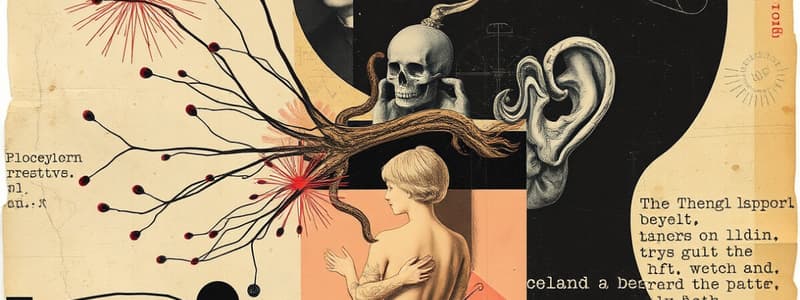Podcast
Questions and Answers
Which of the following are ways to classify sensory receptors? (Select all that apply)
Which of the following are ways to classify sensory receptors? (Select all that apply)
- Stimulus Detected (correct)
- Location (correct)
- Structure (correct)
- Function
What are exteroceptors?
What are exteroceptors?
On or very near body surface; detects pressure, temperature, touch, pain.
What are visceroceptors?
What are visceroceptors?
Within viscera (organs), activated by various stimuli produced by organs.
Interoceptors are another name for exteroceptors.
Interoceptors are another name for exteroceptors.
What do proprioceptors do?
What do proprioceptors do?
What are mechanoreceptors activated by?
What are mechanoreceptors activated by?
Which receptors are activated by changes in temperature?
Which receptors are activated by changes in temperature?
What sensation do nociceptors produce?
What sensation do nociceptors produce?
What do photoreceptors respond to?
What do photoreceptors respond to?
Which of the following is true about free nerve endings? (Select all that apply)
Which of the following is true about free nerve endings? (Select all that apply)
What sensations do Merkel discs provide?
What sensations do Merkel discs provide?
What do Pacinian corpuscles detect?
What do Pacinian corpuscles detect?
What type of structure do Krause's end bulbs have?
What type of structure do Krause's end bulbs have?
Where are muscle spindles found?
Where are muscle spindles found?
What do Golgi tendon receptors detect?
What do Golgi tendon receptors detect?
Flashcards are hidden until you start studying
Study Notes
Classification of Sensory Receptors
- Sensory receptors can be classified based on their location, the stimulus they detect, and their structure.
Types of Receptors by Location
- Exteroceptors: Located on or near the body's surface, these receptors detect external stimuli such as pressure, temperature, touch, and pain.
- Visceroceptors: Found within the organs, these receptors respond to various stimuli indicating internal conditions (e.g., hunger, thirst).
- Interoceptors: Another term for visceroceptors, indicating their role in sensing internal organ conditions.
- Proprioceptors: Specialized visceroceptors found in skeletal muscles, joint capsules, and tendons, providing body orientation and positional information.
Types of Receptors by Stimulus Detected
- Mechanoreceptors: Activated by mechanical changes such as pressure applied to the skin.
- Chemoreceptors: Respond to changes in chemical concentrations, such as those involved in taste, smell, and monitoring pH and blood glucose levels.
- Thermoreceptors: Sensitive to temperature changes.
- Nociceptors: Triggered by intense stimuli that cause tissue damage, resulting in the sensation of pain.
- Photoreceptors: Respond to light stimuli.
Structural Classification of Receptors
- Receptors can be anatomically categorized as either free nerve endings or encapsulated nerve endings.
Free Nerve Endings
- The simplest and most common type of receptor, widely distributed throughout the body.
- Often associated with pain sensations.
Specialized Free Nerve Endings
- Merkel Disks: Detect sensations of light touch through free nerve endings.
- Root Hair Plexuses: Located around hair follicles, these receptors detect hair movement.
Encapsulated Nerve Endings
- Characterized by a connective tissue capsule surrounding the dendritic end of the receptor.
Types of Encapsulated Nerve Endings
- Pacinian Corpuscle: Found deep in the dermis, these receptors are responsible for sensing deep pressure.
- Meissner's Corpuscle: Sensitive to light pressure, located in the dermal papillae.
- Ruffini's Corpuscle: Senses hot temperatures and persistent touch, helping in prolonged grasp of objects, like steering wheels.
- Krause's End Bulb: Located in mucous membranes, these receptors detect touch and cold temperature.
Stretch Receptors
- Muscle Spindles: Present in skeletal muscles, they detect muscle length and stretch.
- Golgi Tendon Organs: Located at musclotendinous junctions, these receptors prevent muscle tearing by detecting muscle tension.
Studying That Suits You
Use AI to generate personalized quizzes and flashcards to suit your learning preferences.




